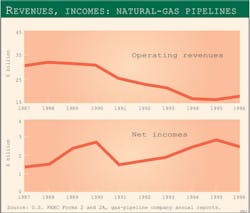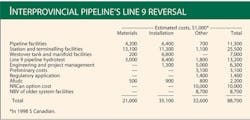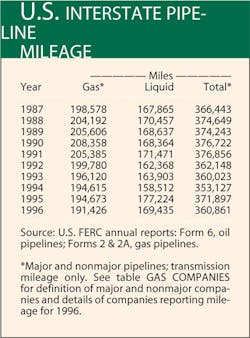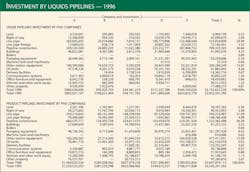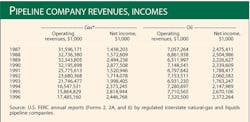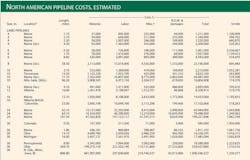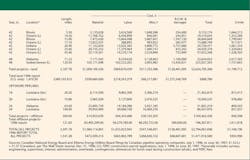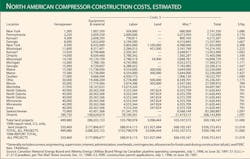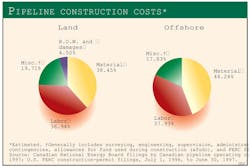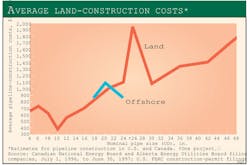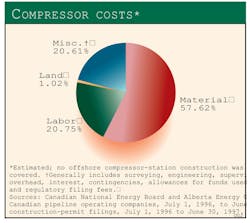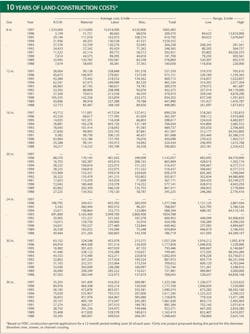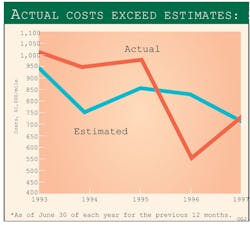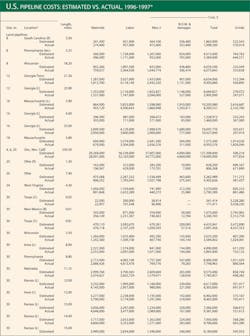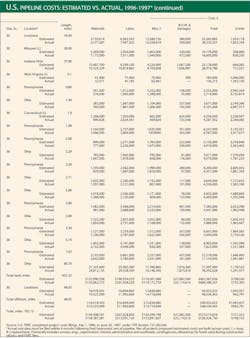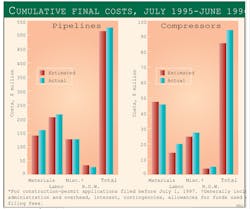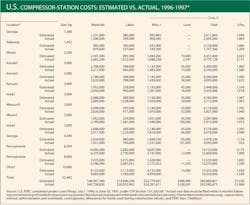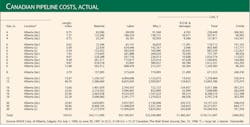Construction Plans Jump; Operations Skid in 1996
Federally regulated oil and gas pipelines turned in mixed performances in 1996, a review of annual reports filed with the U.S. Federal Energy Regulatory Commission (FERC) shows.
Plans for new pipeline construction, filed with both the FERC and Canadian regulatory bodies, increased during a 12-month period ending June 30, 1997.
Natural-gas pipeline operating companies increased their operating revenues but saw their incomes fall (Fig. 1; oil pipelines saw both revenues and incomes fall sharply as deliveries were flat.
Major natural-gas pipelines slightly increased the amounts of gas they moved for a fee and decreased gas sold out of their systems.
In 1996, liquids pipelines moved fewer barrels than a year earlier and reduced in all categories the miles of line operated.
Each year in this exclusive report, Oil & Gas Journal tracks revenues and incomes earned from operations along with volumes moved, as submitted to the FERC by U.S. regulated interstate pipeline companies.
Also, applications for new gas-pipeline construction filed with the FERC during a 12-month period ending June 30, 1997, show a possible wave of new construction over the next 18-36 months. Plans for new construction prior to 1995 had been in a 2-year decline.
And what natural-gas pipelines actually spend to modify or expand their systems had, until last year, been running ahead of what they estimated in initial applications to FERC. This trend was bucked somewhat in companies' final-cost filings with FERC, also through June 30, 1997.
The implications of these construction cost data for all North America are supported by numbers for new construction and completed costs in Canadian activity for the same 12-month period.
The U.S. interstate system
The pipeline-company tables at the end of this report include revenue, income, volumes, mileage operated, and investments in physical plants. Taken together, these numbers offer a look at the U.S. regulated interstate pipeline system available nowhere else.
The Journal began tracking volumes of gas transported for others by major interstate pipelines in the 1988 Pipeline Economics Report (OGJ, Nov. 28, 1988, p. 33). These data have provided a method of tracking the changing U.S. gas-transmission industry.
Reporting changes
Comparing annual U.S. petroleum and natural-gas pipeline mileage must be done carefully.
To begin with, for any calendar year, the number of companies that must file reports with the FERC may vary.
Additionally, comparisons were complicated after 1984 when the FERC instituted a two-tier classification system for companies (OGJ, Nov. 25, 1985, p. 55).
Definitions of the categories can be found at the end of the table "Gas pipelines" (p. 56) and in FERC Accounting and Reporting Requirements for Natural Gas Companies, para. 20.011.
Only major gas pipelines (about one-third of all reporting) are required to file mileage operated in a given year. So-called "non-major" companies may indicate mileage operated, but the information is not specifically required.
For 1984 and several years following, many non-majors did not describe their systems. But in recent years most have been providing such descriptions, including mileage operated.
For 1995, the FERC made an additional change to reporting requirements, this time for petroleum liquids pipeline companies.
In a Final Rule issued Oct. 3, 1995, FERC exempted from requirements to prepare and file Form 6 those pipelines whose operating revenues have been at or less than $350,000 for each of the 3 preceding calendar years.
These companies must file only a Page 700, "Annual Cost of Service Based Analysis Schedule," of the Form 6. This page contains no mileage figures but does note total annual cost of service, actual operating revenues, and throughput in both deliveries and barrel-miles.
And for 1996, major natural-gas pipeline companies were no longer required to report mileage for gathering and storage systems but only for transmission.
Thus, total miles operated for gas pipelines (Table 1) consists entirely of transmission mileage. To continue to convey a 10-year trend, Table 1 has been adjusted to reflect only transmission mileage operated since 1987.
FERC-regulated natural-gas pipeline companies and petroleum liquids pipeline companies operated fewer miles in 1996 than in 1995 (Table 1): final data show a decline of more than 11,000 miles, a decline of nearly 3%.
All transmission-pipeline mileage operated to move natural gas in interstate service declined more than 3,200 miles (1.67%); mileage used in deliveries of petroleum liquids in common-carrier service declined by more than 7,000 miles (4.4%).
Overall gas-transmission mileage declined in 1996, compared to 1995, but transmission mileage for majors increased by 2,500 miles (1.45%).
Gathering lines for liquids companies fell by more than 3,200 miles (-9.1%); crude trunk mileage, by more than 1,700 miles (nearly 2.9%); and product trunk mileage, by more than 2,800 miles (-3.4%).
Whether FERC designates a liquids pipeline company an interstate common-carrier pipeline determines whether the company must file a FERC annual report (Form 6).
Figures for 1996 reflect erratic liquids-pipeline utilization for the past 10 years (Table 1).
Deliveries
Last year, natural-gas pipelines gathered and moved nearly 31 tcf of other companies' gas and sold 1.3 tcf from their own systems. The gas transported for a fee represented a decrease of more than 3.5% over volumes moved in 1995; the gas sold, a 14% drop over volumes sold a year earlier.
For 1995, companies had moved nearly 32 tcf of other companies' gas and sold nearly 1.6 tcf from their own systems. The gas transported was an increase of more than 5% over volumes moved in 1994; the gas sold, a nearly 7% drop over volumes sold a year earlier.
Liquids-pipeline companies saw nearly the same throughput in 1996 as in 1995. Product deliveries dropped by more than 250 million bbl (-4.2%).
This followed an increase in deliveries in 1995 of 4.6%; product deliveries had led that increase with more than 8.1% in 1994.
Crude-oil shipments (more than 55% of total liquids movements) increased by more than 24 million b/d.
Trunkline-traffic (1 bbl moving 1 mile = 1 bbl-mile) for U.S. crude-oil and product pipelines increased 3.2% over traffic for 1995. This increase was led by a 6% growth in product deliveries last year.
Top 10 companies
Oil & Gas Journal ranks the top 10 pipeline companies in three categories (mileage utilized, trunkline traffic, and operating income) for oil-pipeline companies and three categories (mileage, gas transported for others, and net income) for natural-gas pipeline companies.
These rankings are broken out from the accompanying pipeline-company tables.
For all natural-gas pipeline companies, net income as a portion of gas-plant investment in 1996 fell after rising 4 consecutive years and seven times in 8 years.
The term "gas plant" refers to the physical facilities used to move natural gas: compressors, metering stations, and pipelines.
As a portion of gas-plant investment, net income in 1996 was slightly more than 4.1% after reaching nearly 4.9% in 1995 and rising steadily since 1991: 4.2% in 1994, 3.6% in 1993, 3.1% in 1992; and 0.5% in 1991.
This indicator of companies' returns on investment stood at 8.7% in 1984, the year the FERC began (with Order 436) its restructuring of the interstate gas-pipeline industry that culminated in 1992 with Order 636.
Beginning with 1985, net income as a portion of gas-plant investment fell precipitously through 1987 then began its gradual comeback.
All gas-pipeline companies reported for 1996 an industry gas-plant investment totaling nearly $59.5 billion, off slightly from 1995 but still greater than than $57 billion for 1994, $55.6 billion for 1993, and $55.5 billion for 1992.
In 1996, for interstate common-carrier liquids pipeline companies, net income as a percentage of investment in carrier property fell to nearly 8.5% from more than 9.5% in 1995. In 1994, the percentage stood at 8.2% compared to 5.5% for 1993, 7.6% in 1992, and 6.6% in 1991.
Actual investment in carrier property rose to more than $28 billion (+2%) last year, following a rise to nearly $27.5 billion in 1995. It had fallen in 1994 by slightly more than 2.7%. In 1993, it had risen by nearly 16.7%.
For many years, Oil & Gas Journal has been tracking carrier-property investment by five crude-oil pipeline companies and five products-pipeline companies.
Table 2 indicates that investment by the five crude-oil pipelines was more than $2.1 billion, up from $2 billion for 1995, $1.97 billion for 1994, and $1.91 billion for 1993.
Investment in 1996 by the five product pipeline companies was more than $3.6 billion. In 1995, it stood at $3.5 billion; $3.3 billion in 1994; and $3.2 billion in 1993.
Fig. 2 illustrates the investment split in the crude-oil and products pipeline companies.
Another measure of the profitability of oil and natural-gas pipeline companies in recent years is the portion net income represents of operating income (Table 3).
Through 1987, trends for liquids-pipeline companies and for natural-gas pipeline companies had been heading in opposite directions for 10 years.
In 1996 for liquids-pipeline companies, net income as a portion of operating revenues fell to more than 32% from nearly 35% in 1995 and 29.5% in 1994. It was 25.4% in 1993, 28.8% for 1992, and 26.3% for 1991.
As a portion of revenues for all natural-gas companies last year, income fell to slightly less than 14% from 17.75% for 1995 and 14.3% in 1994; it was 9.1% in 1993.
U.S., Canadian construction
Any modification or expansion of gas-transmission facilities in U.S. interstate service requires approval by the FERC.
In Canada, all pipelines must apply to either their provincial regulatory body or to Canada's National Energy Board for such modifications or expansions.
These applications, except under special circumstances for U.S. companies, must contain estimates of what such modifications will cost.
Annual tracking of the mileage and compression horsepower applied for and of the estimated costs indicates future construction. And Oil & Gas Journal has been doing such tracking in this report since its inception 30 years ago (OGJ, Nov. 21, 1994, p. 19).
Canadian figures for major activity were added in last year's report for the first time.
Companies' estimates during the 1996-97 period for what it will cost to construct a pipeline or compressor station are broken out in Table 4 and Table 5.
Those tables cover a variety of locations, pipeline sizes, and compressor horsepower ratings. For 1996, no project was filed with the FERC for a compressor station in federal waters.
Increased activity
For any period, not all projects that are proposed are approved; not all approved ones are eventually built.
Filings during the 12 months ending June 30, 1997, provide a look at the immediate future of gas-pipeline construction on U.S. interstate system and Canadian construction for all types of service:
- Nearly 2,000 miles of land pipeline were proposed for both countries compared to more than 1,400 miles for the 12 months before June 30, 1996 (Table 4).
- Almost 500,000 hp of new or additional compression were applied for in both countries; compared to more than 350,000 hp for the same the year before (Table 5).
Table 4 lists 35 land-pipeline construction projects and 4 marine projects. This compares with 62 land and 2 marine projects in the 1996 Pipeline Economics Report (Nov. 25, 19965, p. 39) and 66 land and 3 marine projects in the 1995 report. The last report covered only U.S. applications.
For the 12 months ending June 30, 1997, the 35 land projects would cost more than $2.6 billion, an increase over the previous 12-month total (for the 62 land projects) of nearly $1.3 billion and the more than $472 million for the same period in 1995.
Combined land and marine construction proposed July 1996-June 1997 was nearly 2,392 miles for almost $2.8 billion.
Cost-per-mile figures may reveal more about cost trends than aggregate costs.
For proposed U.S. gas-pipeline projects in the 1996-97 period surveyed, the average land construction cost per mile was almost $1.2 million. For the 1995-96 period surveyed, the average land cost per mile was more than $898,000.
For the period ending June 30, 1997, the four marine projects (204 miles) proposed averaged more than $830,000/mile. For the 12-months prior to the surveyed period, the 122 miles of planned offshore pipeline amounted an average construction cost of $1.6 million/mile.
Four categories
Year-to-year variations in the four major categories of pipeline construction costs-material, labor, miscellaneous, and right-of-way (R.O.W.)-can also signal trends within each group.
Material costs include those for line pipe, pipe coating, and cathodic protection.
"Miscellaneous" costs generally cover surveying, engineering, supervision, contingencies, allowances for funds used during construction (afudc), administration and overheads, and FERC filing fees.
R.O.W. costs include obtaining right-of-way and allowing for damages.
For the 35 land and 4 offshore projects surveyed for the 1996-97 period covered in this report, costs-per-mile for the four categories were as follows:
- Material-$453,267/mile
- Labor-$432,282/mile
- Miscellaneous-$228,929/mile
- R.O.W. and damages-$53,718/mile.
Table 4 lists proposed pipelines in order of increasing size (OD) and increasing lengths within each size.
The average cost per mile for the projects shows few clear-cut trends related to either length or geographic area.
In general, however, the cost per mile within a given diameter indicates that the longer the pipeline, the lower the incremental cost for construction. And broadly, lines built nearer populated areas tend to have higher unit (per-mile) costs.
Additionally, road, highway, river, or channel crossings and marshy or rocky terrain each strongly affects pipeline construction costs.
Fig. 3, derived from Table 4 for land pipelines, shows the major cost-component split for land and offshore-pipeline construction costs.
Material and labor for constructing land pipelines make up more than 77% of the cost. For offshore projects, material and labor make up more than 75%.
Fig. 4 plots the average pipeline construction cost for land and offshore gas-pipeline construction projects listed in Table 4.
Fig. 5 shows the cost split for land compressor stations based on data in Table 5.
Table 6 lists 10 years of $/mile land-construction costs for natural-gas pipelines with diameters ranging from 8 to 36 in. The table's data consist of estimated costs filed under CP dockets with the FERC, the same data that are shown in Tables 4 and 5.
The average cost per mile for any given diameter, Table 6 shows, may fluctuate from one year to another as projects' costs are affected by geographic location, terrain, population density, or other factors.
Costs-per-mile 1996-97 in Table 6 are somewhat anomalous, compared to former years' figures: two categories traditionally tracked, 20 and 24 in., had no projects proposed for them.
Annual fluctuations in figures in this table, however, are illustrated in construction figures for a 12-in. pipeline.
These fell for the 1997 period, by nearly 2.75% after rising the previous year by more than 22%. This had dropped by more than 30% 1986 to 1987, jumped by more than 47% in 1988, fell again in 1989, leapt by more than 86% in 1990 only to fall sharply in 1991.
What it really costs
What an operator actually spends on an approved and built project must be filed with FERC within 6 months after the pipeline's successful hydrostatic testing or the compressor's being placed in service.
Shown in Fig. 6 are 5 years of estimated vs. actual costs on cost-per-mile bases for project totals.
Table 7 and Table 8 show such actual costs for pipeline and compressor-station projects reported to the FERC during the 12 months ending June 30, 1997. Fig. 7 , for the same period, depicts how total actual costs for each category compared to estimated costs.
Some of these projects may have been proposed and even approved much earlier than the 1-year survey period. Others may have been filed for, approved, and built during the 12-month survey period.
If, in its initial filing, a project was reported in construction "spreads," or mileage segments, that's how projects are broken out in Table 4.
Completed-projects' cost data, however, are usually reported to the FERC for an entire filing, separating only pipeline from compressor-station (or metering site) costs and lumping several diameters together.
Also, actual costs for gas-pipeline construction in Alberta are included in Table 9 .
Overall, actual U.S. gas-pipeline construction costs exceeded anticipated ones by more than $12.9 million.
This was due primarily to material and actual labor costs exceeding expected costs by nearly $15 million. Costs in the other categories fell short of estimates.
Table 8 shows that actual costs for installing compression exceeded estimates by nearly $7.7 million.
Labor costs accounted for much of the difference, exceeding estimates by nearly $5.5 million. Actual material costs were more than $1.2 million less than estimates.
Actual costs for miscellaneous items were greater than estimated by nearly $3.5 million.
Copyright 1997 Oil & Gas Journal. All Rights Reserved.
